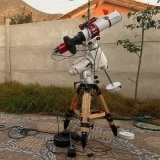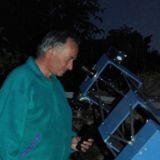INDI Library v2.0.7 is Released (01 Apr 2024)
Bi-monthly release with minor bug fixes and improvements
Live stacking methods?
- David Thompson
-

- Offline
- Senior Member
-

- Posts: 69
- Thank you received: 5
Replied by David Thompson on topic Live stacking methods?
Right now the RPi4 cant boot from USB3 but using the guide in the link below it can be made to use the faster port.
This link shows how to take advantage of this:
jamesachambers.com/raspberry-pi-4-usb-bo...or-ssd-flash-drives/
In my case, the storage benchmark results speak for themselves.
Storage benchmark using
Original SD card only the score was : 1025
With the SSD on USB3 it's : 8430.
It simply files, in fact, it's faster than my Windows 10 laptop.
Please Log in or Create an account to join the conversation.
- Jasem Mutlaq
-
 Topic Author
Topic Author
- Away
- Administrator
-

Replied by Jasem Mutlaq on topic Live stacking methods?
I wish there is a library we could use to make this easier, unless a developer steps in to implement it from scratch based on the existing algorithms in ASTAP and/or CCDCiel.
Noticed both programs seems to use Pascal as well
Please Log in or Create an account to join the conversation.
Replied by han on topic Live stacking methods?
Theoretical for live viewing it would be nice to apply FIFO, first in first out but that would require adding 40 image arrays together for every update. That will probably too much but maybe a stack of the last 10 exposures is feasible with the available computer processing capacity. Applying a dark will be then the 11th action. If you work backwards, you could try to add as much as possible historical images till a watchdog says enough. But it will take a lot CPU load and memory space.
In my opinion, Object Pascal is excellent tool for doing some complicated stuff fast.
Han
Please Log in or Create an account to join the conversation.
- Clive Stachon
-

- Offline
- Elite Member
-

- Posts: 407
- Thank you received: 74
Replied by Clive Stachon on topic Live stacking methods?
it does not need to be a fully integrated into Ekos but an application that runs along side EKOS e.g. it could just be set up to monitor a folder of exposures - e.g. Astrotoaster style (Deep Stacker). Perhaps as PC CCDCIEL works well with Indi you could persuade PC to produce a stand alone (i.e. not part of CCDCIEL) application using just his "stacking" code. NOTE Astrotoaster allows real time colour (Color) etc adjustment.
Bottom line would a RPI 3/4 cope with stacking and not hinder other processors ?
Short exposure stacked images examples (especially see HiloDon from Hawaii) stargazerslounge.com/topic/276321-first-...ith-hyperstar-on-c6/
RPI3 Fedora testing out on AMD desktop Fedpra 28 - running kstars 2.9.4 , Indilib 1.7.4 ?????
Please Log in or Create an account to join the conversation.
Replied by han on topic Live stacking methods?
What live stacking speed would be acceptable?
Han
Please Log in or Create an account to join the conversation.
Replied by Alfred on topic Live stacking methods?
IMO the benefit and main purpose of live stacking is making deep sky objects accessible to visitors. What used to be the view of M42 in an eyepiece (with ppl standing in line waiting for their turn)now becomes an immediately visible M42 on a screen, readily visible for everybody. For the astrophotographer it does not offer any advantages over normal stacking IMO.
Please Log in or Create an account to join the conversation.
Replied by han on topic Live stacking methods?
1) Alignment of unguided images with an exposure time of a few seconds. (Nobody is guiding)
2) Showing intermediate results
This mean you have to stack differently. Assuming the images are A,B,C,D... then
Simple serial stacking:
result1:=A
result2:=(result1+B )/2
result3:=(result2*2+C)/3
result4:=(result3*3+D)/4
result5:=(result4*4+E)/5
....
The only question to ask when to restart serial stacking. If alignment fails a few times?
Han
Please Log in or Create an account to join the conversation.
- Wouter van Reeven
-

- Offline
- Supernova Explorer
-

- Posts: 1957
- Thank you received: 420
Replied by Wouter van Reeven on topic Live stacking methods?
Wouter
Please Log in or Create an account to join the conversation.
Replied by PDB on topic Live stacking methods?
(last time it was the apply button after selecting log histogram). Please detach it from KSTARS before applying new functionality.
Rgrds,
Paul
Please Log in or Create an account to join the conversation.
Replied by han on topic Live stacking methods?
I also had a brief look to DSS live. That looks nice but somehow people are only using it in combination with AstroToaster. What's wrong with DSS live only?
I assume the main benefit is that this solution can be used in Linux. The other programs look pretty established in Windows.
What to do with the input files. Maybe delete? Renaming is possible but it will produce huge amount of data since the setup is most likely operated with short exposure times. If I work this concept further out, I don't want to add more options.
Flowchart for images A, B, C, D...:
result1:=A
plot result1
result2:=(result1*1+B )/2
plot result 2
result3:=(result2*2+C)/3
plot result 3
result4:=(result3*3+D)/4
plot result 4
result5:=(result4*4+E)/5
plot result 5
...
The images in the above process with master dark and flat & flats dark corrected
Viewer maintains the actual view position and zoom factor
Please Log in or Create an account to join the conversation.
- Jasem Mutlaq
-
 Topic Author
Topic Author
- Away
- Administrator
-

Replied by Jasem Mutlaq on topic Live stacking methods?
I already started adding ASTAP integration to Ekos as an alternative solver and hopefully by the next release we'd have something stable.
Regarding how to handle input files, this should be an option, because I could be running an actual sequence and just want to see the how the live stacking is going.
Please Log in or Create an account to join the conversation.
- Patrick Chevalley
-

- Offline
- Elite Member
-

- Posts: 210
- Thank you received: 104
Replied by Patrick Chevalley on topic Live stacking methods?
Han, this is good if you add this function to ASTAP.
From my experience in CCDciel, it work better with a simple addition of each new frame. This is because people doing EAA don't really fear about star saturation but want the faint nebulae level to increase as quickly as possible. When you divide by the number of frame, you keep the faint nebula level very low, as it was on a single image, just with less noise. Also 60 x 5 sec. do not saturate more than 1 x 300 sec.
But the best option is to do the stacking in 32bit floating point, then scale to 16bit for the display.
Maybe with ASTAP you can also try to keep every frame to redo the full stacking each time, in this case you can use sigma clipping to improve the result. If I understand correctly this is what AstroToaster do.
And as Jasem say this can also be used to preview the result of a standard sequence, not only for EAA.
At the moment CCDciel shift the image with a single star alignment before stacking. This work fine with unguided mount but not with alt/az mount. It is good if ASTAP can also apply a rotation but this imply that more than one star can be measured in the frame.
Patrick
Please Log in or Create an account to join the conversation.
